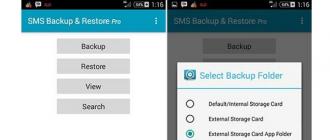Chapters of the article:
Metadata editor Is a special computer program to view, edit, record and delete the metadata of photos during their storage, for any purpose. Such programs exist for different platforms, and they differ in their capabilities, license and user interface.
There are many different programs metadata editors for different types files, but the photographer is interested in programs that understand formats such as EXIF, GPS, IPTC, XMP. There are also many such programs, but they all have their advantages and disadvantages. This should be taken into account when choosing a program for working with metadata.
First, you need to immediately determine what you want, just view or even edit the metadata sections. Second, you need to decide if you need batch file processing in the metadata editor. Third, how important is the functionality of the program to you and are you willing to pay for it.
All metadata editors and other programs that know how to work with them can be conveniently combined into three large groups for selection. Each of them consists of a set of characteristic functions. It can only be viewing the metadata, deleting it completely and editing individual metadata tags. Let's consider each such group separately.
Easy metadata viewing
Viewing metadata from files digital photos that's what they are for, in general. Several store information that can be used to work with photographs. It is more convenient to quickly analyze the metadata of photos not in metadata editors, but in programs for their simple viewing.
There are many simple programs for viewing metadata tags. Each of them has its own characteristics that must be considered when choosing a program for their purposes. To do this, you need to compare them, and then make a choice in favor of a particular program. One of the very convenient such programs is the KUSO Exif Viewer (Fig. 1).

Fig.1 The KUSO Exif Viewer is not a metadata editor, but it is very convenient for viewing them.
Below is a list of programs that are not metadata editors, but in which it is convenient to quickly view them. Detailed description you will find many programs in the following chapters of this article by the links in the overview of these programs below, if any. There will also be given links to download the programs themselves.
ShowEXIF
Firefox ExIF
Firefox Exify
Firefox Viewer
Chrome Exponator
Chrome EXIF \u200b\u200bViewer
Chrome Image Tools
Chrome EXIF \u200b\u200bReader
Chrome View Image Info
Chrome Image Properties Context Menu
FastStone Image Viewer
Shutter Count Viewer
KUSO Exif Viewer
Rawtherapee
Adobe bridge
Opera 12.17
Exif-O-Matic
Picasa
Wipe metadata completely
The second necessary operation for working with metadata is their complete removal from digital photo files. This is sometimes necessary in order to hide information about photos or to reduce their "weight". Most often, metadata is removed when posting photos on the Internet, since this is where it is relevant.
Although completely removing metadata from digital photo files is only one of the editing operations, programs that can do this can be considered metadata editors. They can also be used to view metadata, but not all. Some of them remove metadata without displaying in the interface (Figure 2).

Fig.2 Easy Exif Delete is a simple metadata editor, in which you can only delete them from the selected files, but they are not visible.
There are not so many metadata editors in which they can only be deleted. It is very convenient to use them for this purpose, and therefore we will single them out into a separate group. A detailed description of many of these programs can be found in the following chapters of this article, using the links in the overview below. Links to download them will also be given there.
Total Exif Annihilator
Exif Tag Remover
Easy Exif Delete
JPEG Cleaner
ExifCleaner
Editing metadata
Often, when working with metadata for digital photos, you have to modify or add them to them. new information... This can be done in special programs metadata editors or programs that have such functions. These programs also belong to the Metadata Editors group of programs.
In the metadata editors, you can not only view and delete them, but also edit individual tags. Most of these programs do this for a single file, but there are programs that support batch processing of files. This is very convenient when processing a large number of photo files (Fig. 3).

Fig. 3 Exif Pilot Pro is one of best editors for batch processing of metadata.
Metadata editors differ among themselves not only in the number of tags that can be changed, but also in others useful features to work with them. They also differ user interface and distribution license - there are paid and free ones.
Detailed description popular programs See the links in the overview below for metadata editors. In these articles will be given and links to download the programs themselves. To choose a program for your own purposes, you need to study them, or better compare them in work.
Windows explorer
Adobe Photoshop
Exif Farm Free
Exif Pilot Pro
ExifTool Gui
Lightroom
PhotoME
Exif Pilot
ExifAuto
ImBatch
XnView
Exiftool
Exifer
Gimp
The programs listed in this article are not all the programs for working with metadata that are in the world. As information on other such programs becomes available, links to them will be added to reviews of both metadata editors and metadata viewers.
Read about how to practically use metadata editors in working with photos in the following articles:
Photographers probably know about the Exif data stored in each graphic file... As a rule, they contain information about the date the photo was taken, the device with which the photo was taken, and much other information. It often happens that it is the Exif data of a graphic file that allows you to find out more information about its creator. Today we will consider a small free utility, which allows not only viewing and editing Exif data and EXIF \u200b\u200bGPS, but also exporting and importing them into XML files.

Surely many users will not be satisfied with the number of editable Exif data tags in Exif Farm Free. In this case, the developers have provided the ability to export Exif data, which is not edited directly in the program, to a CSV or XML file. To do this, also, as described at the beginning of the article, open the menu for the file in the Explorer, and select the item Export Exif / Iptc Info... The file will be saved in the same folder where the image is stored.

Then we edit the XML file with the Exif data of the photo in any text editor or specialized utilities... After that, it remains only to erase the Exif data in the graphic file ( Clear Exif / Iptc / Xmp Info) and import them from the edited CSV or XML file ( Import Exif / Iptc Info).

Specifications:
Interface language: English
OS: Windows XP, Vista, 7
File size: 5.3 MB
License: free, there is paid version for batch processing of files
So also inside a photo you can encrypt a huge pile of hidden data. The encryption standard for these so-called metadata, got the name EXIF (Exchangeable Image File Format).
Of course, we are not talking about hidden messages and secret correspondence, although you can arrange it ... First of all, the EXIF \u200b\u200bstandard is used for save and view different characteristics photos, its parameters, indicators, information about the authorship and the object of photography, as well as a lot of other information. That is, metadata is needed only from the point of view of the information component, which means that you can do without them.
The ability to save and view photo metadata is used by many programs. If you are using Windows OS, then most likely you have already encountered EXIF \u200b\u200bdata. Click right click mouse on any photo, in the menu that appears, select at the very bottom the item "Properties".
Further, even though everyone has different version Windows, but the meaning is the same: find and click on the button / tab "Details"... A table will open, where information will be displayed, divided into conditional categories: "Description", "Source", "Image", "Camera", "Enhanced Photo", "File". The information that is displayed in this entire table is nothing more than EXIF \u200b\u200bdata.

Pull down the right property slider and see how many different metadata a photo can have. I am sure in your example, most of the lines will be empty, since you need to fill them in yourself. But the category "Camera" may be filled in - it is automatically filled in by a camera or smartphone.
This is not an exhaustive list of possible metadata. Simply windows developers considered that such a table would be sufficient to cover the main informational aspects of photography. In fact, there can be much more such data! Moreover, this entire volume can be divided into two groups: basic and additional.
The main parameters, I refer to those groups of data that will be read in any program and device that can look into the bins of a photo. These data include: file information, description, copyright, image information, camera data and image conditions. This means that whatever program you use, it will always show you at least this information.
I refer to additional parameters as data that will only work with individual programs. For example, photoshop can create a tab "History" and keep a record of photo editing. Save the photo, open it again after a while, even on another computer, but always through Photoshop, and you can always see what metadata is saved in the "History" tab. But if you try to look into EXIF \u200b\u200busing, for example, Gimp, then this tab will no longer be found.
Many serious programs use this. For example, using EXIF \u200b\u200bdata, it builds a filtering and sorting system for photos, adding keywordsby creating headings and logical generalizations. This allows you to easily find the desired images among tens of thousands.
EXIF data can be mutable and immutable.
Changeable, in turn, can be divided into two more subspecies:
— human editable, for example, indicate the author of the picture yourself, and later delete and write a new name;
— editable by the program, for example, when you save a photo in Photoshop, the program itself adds a tag that the photo has been modified in Photoshop version of such and such... You yourself cannot register or delete this tag (unless through special software, but that's another story), but if you resave the photo in Photoshop another version, then the tag will be changed again in part of the version, for example, it was CS5, but now it is CS6.
Immutable data is recorded by programs and devices without your will and remains firmly with this photo, for example, picture resolution, file format, creation date, camera data.
Why and how to use EXIF \u200b\u200bdata?
- First of all it is very convenient entry information about the picture, well, do not keep in the notepad notes with what exposure you took this or that picture! Everything is written down conveniently in a file, when you need it, you opened it, looked it up, remembered it.
- This is proof of your authorship of the photo if you enter all necessary information About Me.
- At the expense of the notebook, I'm not far from the truth. You can also open the desired photo and enter the information you need there. It will be safely stored there and will not go anywhere. But I remind you that you will have to view it through the same program.
- Did you like / dislike the quality of the captured image? - Analyze the data in the "Camera" category. There you will find out under what conditions and camera settings this picture was taken. Admired / found a mistake - gained invaluable experience.
- Professional image browsers, for example, sort and filter large masses of photos by EXIF \u200b\u200bmetadata.
- Send a love message to a little man, or encrypt secret data and take / send them out of the country \u003d))
Thirdly, the Internet is full of online services for working with EXIF \u200b\u200bmetadata. Their advantage is that you don't have to install anything on your computer. I did this operation once and forgot.
Of the minuses, I will note the speed of work - it directly depends on the capabilities of your Internet tariff.
An example of a site for removing EXIF \u200b\u200bonline - IMGonline.com.ua.
If you spot an error in the text, select it and press Ctrl + Enter. Thank you!
EXIF data does contain a lot of information about a photo, but when it comes to uploading photos to the Internet, which almost everyone does in our age, there is a double question - whether to leave or delete this data.
EXIF is useful because it contains confirmation that the photo was taken from your camera, which, for example, can help. Also, EXIF \u200b\u200bis useful simply when studying photographs of the masters, when you are interested in how the aperture, shutter speed and other shooting parameters were set. Here's how, for example, on the site 500px.com:
However, EXIF \u200b\u200bmay contain, if not confidential, then at least unwanted information for the whole Internet. In this case, it becomes necessary to delete this data, although this does not exclude cases of deleting EXIF \u200b\u200bin order to simply hide whose picture it is and use it as your own. In general, this is a rather difficult question, and it's up to you - to delete or leave EXIF \u200b\u200bdata, but my goal is to show how 🙂
Let's start with the fact that there is an excellent service StolenCameraFinder.com, which in case of loss of the camera will prompt it serial number, even if you have not recorded it, and will automatically find photos from your camera - you just need to drop one of the past pictures taken with your camera into the window of this site. True, the test with my photos gave only 4 results 🙁 although there are a hundred times more of my photos on the net.
GadgetTrack.com, which has become even more popular thanks to the fact that it helped, did give a lot more results on my photos - in total, according to the site, they indexed more than 10.4 million serial numbers. However, this service does not automatically detect the serial number: for this you will have to look into EXIF one of your pictures yourself, according to one of the methods shown in the article about that,.
What if you all do not want to reveal the details of the photo?
Again, there are several ways here.
1. The easiest way edit EXIF was described in the last lesson - just right-click on the file and go to the Properties menu item, go to the Details tab and click on the Remove Properties and Personal Information link. In the window that opens, choose which data to delete, and which to leave and whether to leave at all.

2. The next method is convenient when processing a photo and saving it for later publication on the Internet. Photoshop has a special function for this File -\u003e Save for Web & Devices or just type t + Shit + Ctrl + S. Here you need to select the file format, in particular, jpg and in the metadata field indicate how you want edit exif data - what to leave and what to remove, or even remove all exif data.


Photo Exif Editor - Exif editor allows you to view, modify and delete Exif data of your photos
EXIF - this abbreviation should definitely be familiar to photographers, since it is in the photo that there is special meta-data, which indicates not only information from the camera itself (shutter speed, exposure, camera model, etc.), but you can also specify personal data from the author ( more detailed information see Wikipedia). To edit this metadata on a PC, it is enough to download and install any utility, of which there are many now, but on Android there are just one or two such tools. Photo EXIF \u200b\u200bEditor allows you to easily edit this data in any photo.
On the main screen, you will find 4 buttons, each of which will allow you to select one of the photos. The first button that might interest you is PhotoMap. With its help, you can see all the marks on the map, not based on the photos you took (this is provided that in the device's camera settings you have chosen the option of recording geotags in meta data). The next two buttons, Browse and Gallery, will allow you to quickly find the desired photo, only the first one opens file managerand the second is a gallery. The last button launches the camera and then allows you to instantly change the metadata. The editor itself is very simple and you just need to click on the field to edit it. If you just want to delete any data from the photo, then click on the special Remote EXIF \u200b\u200bbutton. All entered data is saved immediately.
The application has no settings, it works perfectly and without any complaints. Photo EXIF \u200b\u200bEditor perfectly coped with the task and we can safely say that at the moment it is one of the best in Google play (competitors are very, very bad).
Features::
- Viewing and editing EXIF \u200b\u200binformation from Android galleries or from the integrated photo browser of the program.
- Add or correct the location where the photo was taken using Google Maps.
- Batch editing of multiple photos.
- Delete all photo information to protect your privacy.
- Adding, modifying EXIF \u200b\u200btags: Camera model, Camera manufacturer, Shutter speed, Orientation (rotation), Aperture, Shutter speed, Focal length, ISO, White balance. And much more...
Download Photo Exif Editor app ( exif editor - change Exif data of photos) on Android you can follow the link below.
Developer: Banana Studio
Platform: Android 4.0 and above
Interface language: Russian (RUS)
Condition: Pro (Full version)
Root: Not Needed






